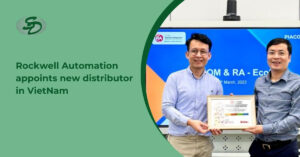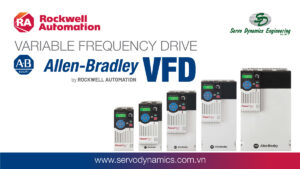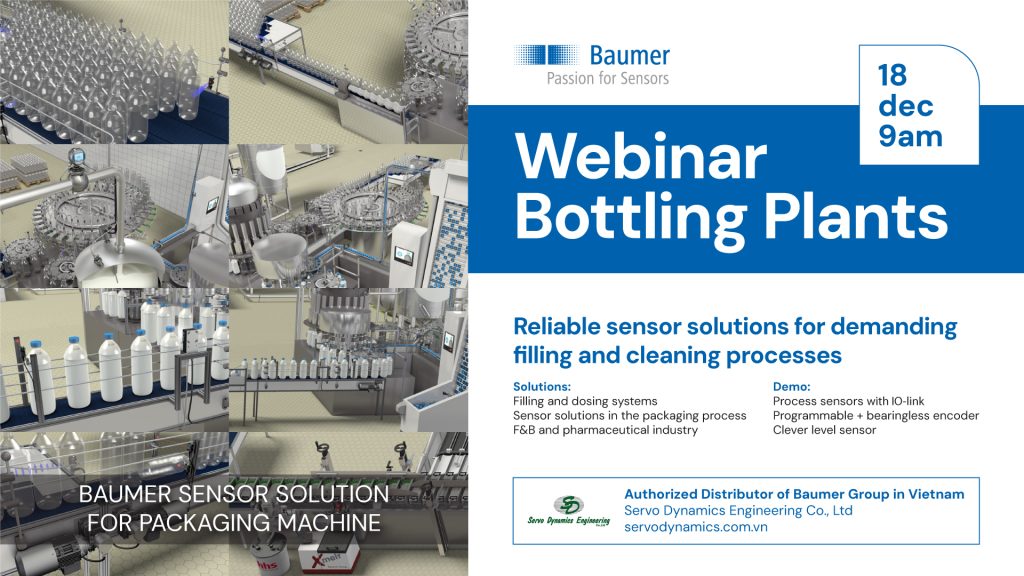Consulting, Industrial Automation, News, Solutions
Soft Starter: Definition, Structure, and Operating Principle
Are you looking for a solution to optimize your motor startup process, minimize mechanical damage, and protect your electrical system? The Soft Starter is the answer. This article by Servo Dynamics will delve into the definition, structure, operating principle, and guide you on choosing the most suitable Soft Starter for your application.
What is a Soft Starter?
Components of a Soft Starter

A Soft Starter is a combination of power electronic components and intelligent control circuitry.
SCR Module (Thyristor)
This is the core component, consisting of 6 anti-parallel Thyristors, forming 3 pairs, responsible for controlling the AC current on the 3 phases supplied to the motor. The ability to control the SCR’s firing angle determines the effective voltage supplied to the motor.
Microprocessor Control Unit
The brain of the Soft Starter, performing functions such as:
- Implementing control algorithms (Voltage Ramp, Current Limit, Torque Control).
- Processing signals from sensors.
- Monitoring and activating protection features.
- Communicating with users and higher-level systems (PLC/SCADA).
Display Unit – User Interface
Includes LED/LCD screens and buttons (such as Start, Stop, Program, Enter) that allow operators to set parameters like start time, current limit, and monitor operating status/errors.
Current and Voltage Sensors
Measure the actual current and voltage passing through the power circuit to provide feedback to the microprocessor, ensuring precise control and activating protection in case of failure.
Bypass (Integrated or External)
The Bypass Contactor is a contactor that closes when the motor reaches its rated speed. Its purpose is to supply power directly to the motor, removing the Thyristors from the circuit. This helps to:
- Reduce power loss and heat generated by the SCRs.
- Increase the efficiency and lifespan of the Soft Starter.
Integrated Protection Devices
Modern Soft Starters integrate protection features such as:
- Overcurrent/Overload protection.
- Phase Loss/Phase Reversal protection.
- Overtemperature protection.
- Stall/Locked Rotor protection.
Function of a Soft Starter
The core function of a Soft Starter is to control the motor’s power-on and power-off sequence, aiming to:
- Reduce Starting Current: Limit the inrush current, typically 5-8 times the rated current, when the motor begins operation.
- Reduce Starting Torque: Control the torque generated, preventing mechanical shock.
- Protect the Motor and Drive System: Integrate electrical protection features (overcurrent, phase loss, overtemperature).
What is a Soft Starter used for?
Soft Starters are used to optimize the performance and extend the lifespan of mechanical and electrical systems with high inertia loads or those requiring smooth starting/stopping, such as pumps, industrial fans, conveyors, and compressors.
Advantages of Soft Starters
Using a Soft Starter offers many superior benefits compared to traditional methods like Direct-On-Line (DOL) or Star-Delta starting:
Reduced Starting Current – Equipment Protection
By limiting the starting current (typically set at 300-450% of the rated current instead of 600-800%), the Soft Starter helps to:
- Prevent voltage dips on the power grid.
- Reduce thermal and electrical stress on the motor windings.
Increased Lifespan of Motor and Drive System
Minimizing abrupt torque protects mechanical components such as gearboxes, couplings, chains, and belts from wear and tear caused by vibration and mechanical shock.
Prevents Voltage Dips in the System
Lower starting current helps maintain stable voltage quality for other equipment on the same electrical network, which is crucial in plants with limited power supply.
Smooth Operation – Reduced Vibration and Mechanical Shock
The smooth acceleration process eliminates jolting during startup (especially important for conveyors) and prevents water hammer when stopping pumps (Soft Stop function – Ramp Down).
Easy to Set Up, More Cost-Effective than VFDs
Compared to Variable Frequency Drives (VFDs), Soft Starters have a simpler structure, are easier to install, and the initial investment cost is often lower, especially when the application only requires control over starting and stopping without continuous speed adjustment.
The difference between Soft Starter vs. Variable Frequency Drive (VFD)
Although both soft starters and Variable Frequency Drives (VFD) are used to control electric motors, they serve different functions and applications:
| Feature | Soft Starter | Variable Frequency Drive (VFD) |
| Primary Function | Reduces inrush current and starting torque |
Controls motor speed and torque by varying frequency and voltage
|
| Operating Principle | Controls voltage or current using thyristors during start-up and shutdown |
Modifies input power frequency and voltage through rectifier, filter, and IGBT inverter
|
| Speed Control | No speed control during normal operation (typically bypassed after startup) |
Provides continuous and precise motor speed control throughout operation
|
| Torque Control | Limits starting torque; some models offer basic torque control during startup |
Provides accurate and flexible torque control across various operating conditions
|
| Energy Efficiency | Reduces energy loss during startup; may improve efficiency in soft-stop applications |
Significant energy savings in variable load applications by adjusting motor speed to demand
|
| Complexity | Relatively simple in structure and operation |
More complex due to multiple energy conversion stages
|
| Cost | Generally lower cost than VFD for the same power rating |
Typically higher cost than soft starters for the same power rating
|
| Typical Applications | Starting pumps, fans, conveyors, compressors where speed control is not required after startup |
Speed control for pumps, fans, conveyors, CNC machines, robots, HVAC systems requiring flexible speed and torque adjustments
|
Operating Principle of a Soft Starter
The core principle of a Soft Starter is to adjust voltage/current over time.
Controlling Motor Voltage via SCR
By varying the firing angle (alpha) of the Thyristor pairs, the Soft Starter can adjust the effective voltage V_rms supplied to the motor. The larger the angle alpha, the smaller the voltage V_rms, resulting in lower current and torque generated.
Startup Phase – Voltage Increase via Ramp Up
The startup process is controlled via a Ramp Up slope:
- Start Voltage: Starts at a pre-set low voltage to create minimum required torque.
- Ramp Time: During this period, the Soft Starter gradually increases the SCR firing angle, linearly or non-linearly increasing the voltage from the Start Voltage to the Full Voltage, helping the motor accelerate smoothly.
Run Phase – Bypass Activation
When the motor reaches rated speed and the Ramp Time concludes, the Soft Starter signals the Bypass Contactor (if equipped) to close. The current then flows directly through the Contactor, and the Soft Starter only maintains monitoring and protection functions.
Soft Stop Phase – Ramp Down
This is an optional feature, known as Soft Stop. The process is reversed from startup:
- Upon receiving the stop command, the Bypass Contactor opens (if closed).
- The Soft Starter begins to reduce the voltage supplied to the motor according to a descending ramp (Ramp Down Time).
- The reduced voltage causes the motor to gradually decelerate until it stops completely. This feature is critically important for preventing water hammer in pumping systems.
Difference from Direct-On-Line (DOL) and Star-Delta Starting
| Method | Starting Current | Torque | Control | Typical Applications |
|---|---|---|---|---|
| DOL | Very High (600-800% of rated) | High, abrupt | None | Small loads, no smooth requirement |
| Star-Delta | Lower than DOL (approx. 300% of rated) | Low (approx. 33% of rated), with jolting during transition | Fixed two steps | Medium loads, no soft stop needed |
| Soft Starter | Low and adjustable (300-450%) | Adjustable, smooth | Continuous, programmable | Heavy loads, smooth operation, anti-mechanical shock |
Wiring Diagrams and Soft Starter Connection
Connecting a Soft Starter requires strict adherence to electrical safety standards and the manufacturer’s diagrams.
3-Phase Soft Starter Circuit Diagram
The most basic diagram is Direct Connection (In-Line), where the Soft Starter is placed in series between the Power Source (Line) and the Motor (Load).
- Source: L1, L2, L3 (or R, S, T)
- Motor: T1, T2, T3 (or U, V, W)
Soft Starter Wiring Diagram with Bypass
For continuously operating applications, an external Bypass Contactor should be used.
- The Soft Starter only operates during Ramp Up and Ramp Down.
- After starting, the Bypass Contactor closes, supplying direct power, extending the lifespan and reducing heat for the Soft Starter.
Allen-Bradley Soft Starter Wiring
Allen-Bradley Smart Motor Controllers™ like SMC-3, SMC-Flex, or SMC-50 often offer advanced wiring options such as Inside Delta (connection within the motor’s Delta winding), which helps reduce the required size of the Soft Starter for the same motor:
- The current passing through the Soft Starter is only 58% of the motor’s rated current (phase current).
- Allows for the use of a significantly smaller capacity Soft Starter.
Notes on Soft Starter Wiring
- Cables: Select cable cross-sections suitable for the rated current and maximum starting current of the Soft Starter.
- Short Circuit Protection: Always install fuses or a Circuit Breaker at the input to protect the Soft Starter from short circuits.
- Grounding: Full grounding connection must be made for both the Soft Starter and the motor.
- Bypass Equipment: If using a Bypass Contactor, ensure the Contactor has a current rating equivalent to or greater than the motor’s rated current.
Applications of Soft Starters in Industry
Soft Starters are widely used in various industries for applications with inertial loads, requiring smooth operation.
Soft Starters for 3-Phase Motors
This is the most common application, from small motors of a few kW to large motors of hundreds of kW, especially in heavy industrial environments.
Soft Starters for Pumps
Controls the acceleration and deceleration process to eliminate the Water Hammer phenomenon—a sudden pressure surge in the pipeline when the pump stops.
Soft Starters for Conveyors
Ensures smooth starting and stopping of conveyors, preventing material shifting or spillage, and reducing wear on drive components (belts, gearboxes).
Applications in Industrial Fans, Compressors
For fans, it minimizes stress on the blades and ventilation system. For compressors, the Soft Starter ensures smooth startup even when the compressor already has residual pressure.
Applications with 1-Phase and DC Motors (Supported)
Although Soft Starters are primarily designed for 3-phase AC motors, some specialized Soft Starter models can support controlling certain types of 1-phase or DC motors, though this is not a standard application.
Soft Starter Models by Power Rating
Soft Starters have a wide power range, suitable for motors of all sizes:
22kW Soft Starters
Typically used for industrial water pumps, small fans, and mixers in medium-sized production lines.
30kW Soft Starters
Commonly used for HVAC systems, primary water supply pumps, or medium-load conveyors.
45kW – 75kW Soft Starters
Used for heavier load applications such as grinders, large-capacity compressors, and heavy material handling systems.
Large Capacity Soft Starters 132kW – 250kW
Intended for super-heavy-duty motors, such as subway train motors, blast furnace fans, or pumping/ventilation systems in the mining and oil and gas industries.
Soft Starter Classification by Brand
The Soft Starter market is diverse with many major brands, each focusing on specific market segments and features.
Allen-Bradley (Rockwell Automation) Soft Starters
Known for their Smart Motor Controllers (SMC) series such as SMC-3, SMC-Flex, and SMC-50. These products offer intelligent control capabilities and deep integration with the FactoryTalk system and EtherNet/IP network.
ABB Soft Starters (PSTX, PSE…)
ABB’s PSTX (Advanced Softstarter) and PSE (New Softstarter) series are known for high reliability, comprehensive protection features, and precise torque control capability.
Schneider Soft Starters (ATS22, ATS48, ATS480)
Schneider Electric offers the Altistart (ATS) series, where ATS48 is a long-standing and popular model, while ATS22 and ATS480 are newer series with enhanced communication and protection features.
Siemens Soft Starters
The Siemens Sirius series provides numerous options, from compact Soft Starter modules to high-power devices, focusing on efficiency and integration into automation systems.
Chint Soft Starters
A popular brand offering cost-competitive Soft Starter solutions, suitable for basic applications.
Danfoss Soft Starters
Often integrate energy-saving features and focus on pump and fan applications.
Delta / Eaton / AuCom Soft Starters
Other brands offering Soft Starter solutions with specialized features and diverse power ranges.
Allen-Bradley/Rockwell Automation Soft Starters
Rockwell Automation is a leading brand in industrial automation, providing high-quality, reliable soft starters with advanced features.
The Smart Motor Controllers™ Soft Starters help reduce system power consumption, minimize wear and tear, and optimize operating costs. This solution integrates seamlessly into control systems, enhancing efficiency and reducing downtime.
Discover popular Rockwell Automation soft starter models:
How to Choose the Right Soft Starter
Choosing the right Soft Starter requires considering not only the power rating but also the load characteristics and operating environment.
Based on Motor Power
The Soft Starter must have a rated capacity and voltage (Horsepower/kW and Volts) equal to or greater than the motor. Pay attention to selecting the rating for In-Line or Inside Delta connection.
Based on Rated Current and Starting Current
The Soft Starter must be able to withstand the motor’s Full Load Amps (FLA) and the maximum Peak Starting Current required by the application.
Light-Duty vs. Heavy-Duty Applications
- Light Duty: Fans, centrifugal pumps, where the starting time is short. A slightly lower-rated Soft Starter may be chosen.
- Heavy Duty: Grinders, long conveyors, where a longer acceleration time or heavy load starting is required. A higher-rated Soft Starter with a heavy-duty cycle must be selected.
Operating Environment and Protection Rating
Choose equipment with an appropriate protection rating (IP/NEMA) for the installation environment (dust, humidity, high temperature). Consider the ability to operate at high temperatures without derating.
When to Use a VFD instead of a Soft Starter
Use a Variable Frequency Drive (VFD) instead of a Soft Starter when:
- Speed Control is Required: Need continuous variation of motor speed (e.g., adjusting fan/pump flow).
- High Torque is Needed at Low Speed: Lifting applications, cranes.
- Precise Positioning is Required: CNC machine tools, Robots.
Common Faults and Troubleshooting
Most Soft Starter faults are related to overheating, overcurrent, or phase issues.
Reasons for Soft Starter Thermal Protection/Overcurrent Errors
- Overcurrent/Overload:
- Mechanical load is too heavy, starting time is too long.
- Starting current limit setting is too low.
- Short circuit or ground fault in the motor/cable.
- Thermal Protection/Overtemperature:
- Too high starting frequency (Hot Restart).
- Poor heat dissipation (clogged fan, installed in confined space).
- Incorrect Thermal Curve setting.
Guide to Reset and Fault Checking
- Record the Fault: Note the error code displayed on the Soft Starter (e.g., O-C, OC-1, O-T) for reference in the manual.
- Disconnect Power: Turn off the main power supply.
- Inspect: Check the motor, cables, and mechanical load to determine the cause (e.g., motor stuck, coupling damage).
- Cool Down: If it is an overtemperature fault, wait for the Soft Starter to cool down completely.
- Reset: Execute the Reset command via the interface or control signal. If the error persists, professional engineer support is needed.
FAQ – Frequently Asked Questions about Soft Starters
How is a Soft Starter different from a VFD?
Core Difference:
- Soft Starter: Only controls voltage/current during start and stop. Does not control speed during stable operation (often uses Bypass).
- VFD: Controls frequency and voltage to continuously adjust motor speed throughout the operation.
Does a Soft Starter save energy?
Yes, but not by regulating speed. A Soft Starter saves energy by:
- Reducing Thermal Losses due to lower starting current.
- Using Bypass to eliminate power loss across the Thyristors during stable operation.
- The Soft Stop function helps reduce wasted energy from friction and abrupt inertia.
Can a Soft Starter be used for household water pumps?
Technically yes, but it is usually unnecessary and cost-ineffective because household motors (often 1-phase, small capacity) are designed to withstand their starting current. Soft Starters are primarily intended for 3-phase industrial motors.
When should a Bypass be used for a Soft Starter?
Bypass (integrated or external) should be used in cases where:
- Long Operating Time: Pump or fan applications running 24/7.
- Loss Reduction: Reduces heat generation and increases efficiency.
- Increased Lifespan: Extends the lifespan of the Soft Starter unit itself.
Servo Dynamics Engineering: Value-add Distributor of Rockwell Automation in Vietnam
Servo Dynamics is the official distributor and strategic partner of Rockwell Automation (Allen-Bradley) in Vietnam. We specialize in providing world-leading Smart Motor Controllers (SMC) Soft Starter solutions.
With deep expertise in automation, we not only supply genuine products but also provide professional technical support, consulting on wiring diagrams (including Inside Delta), and programming to optimize performance for your system, ensuring reliability and reducing operating costs.
To receive in-depth technical consulting on Allen-Bradley/Rockwell Automation Soft Starter models, please contact our team of engineers today.

 Tiếng Việt
Tiếng Việt












